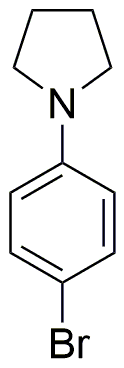1-(4-Bromophenyl)pyrrolidine is widely utilized in research focused on:
- Pharmaceutical Development: This compound serves as a key intermediate in the synthesis of various pharmaceuticals, particularly in the development of drugs targeting neurological disorders.
- Organic Synthesis: It acts as a versatile building block in organic chemistry, enabling the creation of complex molecules for research and industrial applications.
- Material Science: The compound is used in developing novel materials, including polymers and coatings, which can enhance durability and performance in various applications.
- Biochemical Research: It plays a role in studies related to receptor binding and enzyme inhibition, providing insights into biological processes and potential therapeutic targets.
- Agrochemical Formulations: The compound is explored for its potential use in agrochemicals, contributing to the development of more effective pesticides and herbicides.
Informations générales
Propriétés
Sécurité et réglementation
Applications
1-(4-Bromophenyl)pyrrolidine is widely utilized in research focused on:
- Pharmaceutical Development: This compound serves as a key intermediate in the synthesis of various pharmaceuticals, particularly in the development of drugs targeting neurological disorders.
- Organic Synthesis: It acts as a versatile building block in organic chemistry, enabling the creation of complex molecules for research and industrial applications.
- Material Science: The compound is used in developing novel materials, including polymers and coatings, which can enhance durability and performance in various applications.
- Biochemical Research: It plays a role in studies related to receptor binding and enzyme inhibition, providing insights into biological processes and potential therapeutic targets.
- Agrochemical Formulations: The compound is explored for its potential use in agrochemicals, contributing to the development of more effective pesticides and herbicides.
Documents
Fiches de données de sécurité (FDS)
La FDS fournit des informations de sécurité complètes sur la manipulation, le stockage et l’élimination du produit.
Spécifications du produit (PS)
Le PS fournit une description complète des propriétés du produit, notamment sa composition chimique, son état physique, sa pureté et les exigences de stockage. Il détaille également les plages de qualité acceptables et les applications prévues du produit.
Certificats d'analyse (COA)
Recherchez des certificats d'analyse (COA) en saisissant le numéro de lot du produit. Les numéros de lot et de lot se trouvent sur l'étiquette d'un produit, après les mots « Lot » ou « Lot de fabrication ».
Numéro de catalogue
Numéro de lot/série
Certificats d'origine (COO)
Ce certificat d'exploitation confirme le pays dans lequel le produit a été fabriqué, et détaille également les matériaux et composants utilisés et s'il est issu de sources naturelles, synthétiques ou autres sources spécifiques. Ce certificat peut être requis pour les douanes, le commerce et la conformité réglementaire.
Numéro de catalogue
Numéro de lot/série
Fiches de données de sécurité (FDS)
La FDS fournit des informations de sécurité complètes sur la manipulation, le stockage et l’élimination du produit.
DownloadSpécifications du produit (PS)
Le PS fournit une description complète des propriétés du produit, notamment sa composition chimique, son état physique, sa pureté et les exigences de stockage. Il détaille également les plages de qualité acceptables et les applications prévues du produit.
DownloadCertificats d'analyse (COA)
Recherchez des certificats d'analyse (COA) en saisissant le numéro de lot du produit. Les numéros de lot et de lot se trouvent sur l'étiquette d'un produit, après les mots « Lot » ou « Lot de fabrication ».
Numéro de catalogue
Numéro de lot/série
Certificats d'origine (COO)
Ce certificat d'exploitation confirme le pays dans lequel le produit a été fabriqué, et détaille également les matériaux et composants utilisés et s'il est issu de sources naturelles, synthétiques ou autres sources spécifiques. Ce certificat peut être requis pour les douanes, le commerce et la conformité réglementaire.


